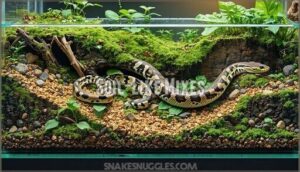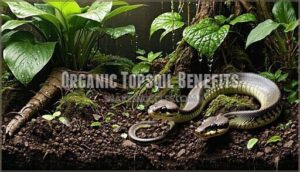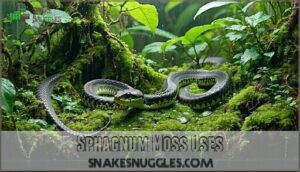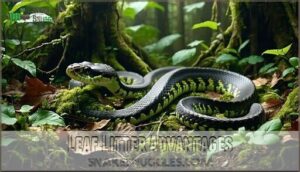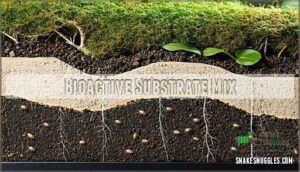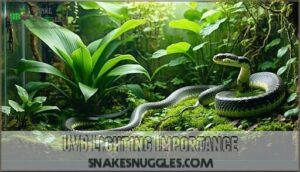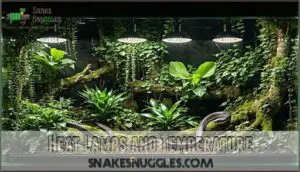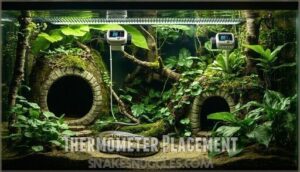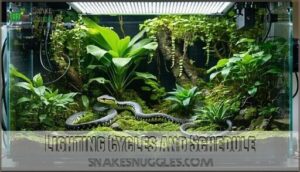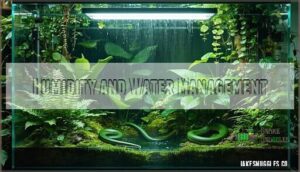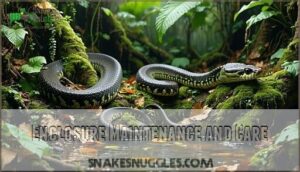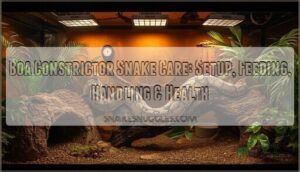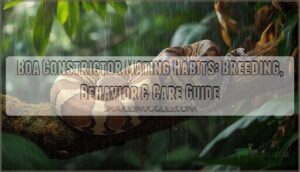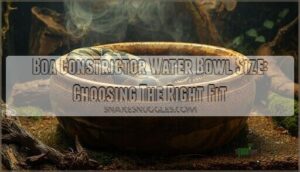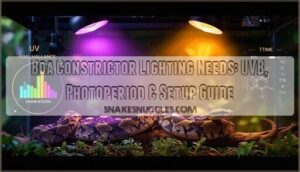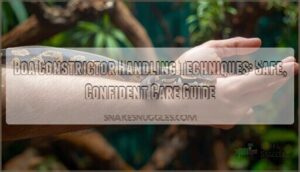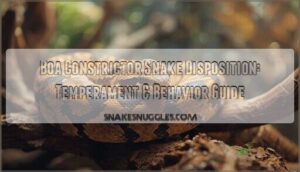This site is supported by our readers. We may earn a commission, at no cost to you, if you purchase through links.
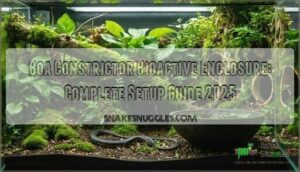
You’ll want a roomy terrarium—think at least as long as your snake—and a mix of organic topsoil, sphagnum moss, and leaf litter to mimic nature’s carpet.
This supports humidity and lets beneficial bugs do the cleanup. Add sturdy branches and hides for climbing and privacy, and don’t forget a big water bowl for soaking.
Good lighting and a stable temperature keep your boa healthy. Keeping this ecosystem balanced is part science, part art—just wait until you see how it all comes together, creating a thriving ecosystem.
Table Of Contents
- Key Takeaways
- Choosing Terrarium Size
- Selecting Substrate Options
- Enclosure Lighting Setup
- Humidity and Water Management
- Enclosure Maintenance and Care
- Frequently Asked Questions (FAQs)
- Can snakes live in a bioactive enclosure?
- What are the cons of bioactive enclosures?
- How do I make my snake enclosure bioactive?
- How much humidity does a boa constrictor need?
- Can boa constrictors escape from bioactive enclosures?
- What plants are safe for boa terrariums?
- How often should cleanup crew be replaced?
- Do bioactive setups smell or attract insects?
- Can multiple cleanup crew species coexist together?
- Conclusion
Key Takeaways
- You’ll need at least one square foot of floor space per foot of snake length – Measure your boa carefully and plan for growth, as upgrading later costs more than starting with adequate space.
- Create a 4-12 inch deep substrate mix using organic topsoil, sphagnum moss, and leaf litter – This foundation supports beneficial microorganisms and maintains proper humidity while allowing natural burrowing behaviors.
- Maintain 55-75% humidity with proper lighting and temperature gradients – Use digital hygrometers and establish a basking spot at 88-90°F while keeping the cool side at 75-80°F for optimal health.
- Add cleanup crews like isopods and springtails to create a self-sustaining ecosystem – These beneficial organisms break down waste naturally, reducing your maintenance to occasional spot cleaning rather than complete substrate replacement.
Choosing Terrarium Size
You’ll need to determine the correct terrarium size by accurately measuring your boa constrictor’s length using a flexible measuring tape while the snake is relaxed.
The general rule requires at least one square foot of floor space per foot of snake length, plus adequate vertical height for their semi-arboreal climbing behavior, following a basic principle of providing sufficient space for the snake’s overall well-being, including semi-arboreal activities.
Measuring Snake Length
Accurately measuring your boa constrictor’s length requires flexible tools and careful technique for proper enclosure design.
**Precision in measurement equals success in your snake’s future home.
This measurement directly impacts your snake bioactive setup and guarantees long-term suitability as your reptile grows.
Here are five essential methods for accurate measurement:
- Flexible tape method – Place tape along the snake’s dorsal line from snout to tail tip
- String technique – Use string to trace body length, then measure against a ruler
- Wall alignment – Guide snake against a straight surface, marking head and tail positions
- Photogrammetry – Photograph snake with known-size reference object for digital calculation
- Tube restraint – Secure defensive snakes in clear tubes for safe, precise measurement
Consider growth patterns when planning your bioactive boa enclosure, as measurements determine both current needs and future expansion requirements for your boa constrictor bioactive vivarium.
These snakes are popular due to their docile and curious nature.
Calculating Floor Space
You’ll calculate floor space using the standard formula: length × width equals total square footage.
For a 6-foot boa constrictor bioactive setup, you need minimum dimensions of 6’L × 3’W (18 sq ft). However, larger boas exceeding 8 feet require 8’L × 4’W enclosures.
Remember to factor in future growth when planning your snake bioactive setup, as upgrading later costs more than starting with adequate space. It’s important to keep in mind adequate enclosure ventilation for your boa’s health and overall well-being, ensuring a bioactive setup that meets their needs.
Considering Vertical Space
Your boa constrictor’s semiarboreal nature demands vertical space for ideal health and exercise.
Height benefits include muscle development, stress reduction, and natural behavior expression in your bioactive enclosure.
Plan for climbing structures that utilize the full vertical dimension of your snake enclosure. Natural habitat replication reduces stress and promotes health.
- Sturdy climbing branches positioned at varying heights throughout the terrarium
- Cork bark tubes creating elevated hideouts and arboreal enrichment opportunities
- Living or artificial plants providing secure climbing surfaces and visual barriers
- Multiple levels of perches allowing your boa exercise while maximizing space utilization
Enclosure Size Formula
The standard Length Multiplier formula simplifies boa constrictor enclosure planning: snake length × 0.5 × 0.5 for dimensions.
For a 6-foot snake, you’ll need 6’L × 3’W × 3’H Minimum Dimensions.
Height Calculation becomes critical since boas are semi-arboreal climbers.
Species Variance matters—Boa constrictor constrictor requires larger reptile enclosure dimensions than Boa imperator.
Consider a Grow-out Tank approach, starting with appropriate snake enclosure size that accommodates future growth rather than frequent upgrades.
Selecting Substrate Options
The substrate you choose forms the foundation of your boa’s bioactive ecosystem, directly impacting humidity, plant growth, and beneficial microorganism development.
Creating the right soil-like environment requires careful selection of organic materials that work together to mimic your snake’s natural tropical habitat.
Soil-Like Mixes
Through the layers of your bioactive substrate boa setup, you’ll create a foundation that mimics nature’s forest floor perfectly.
The soillike substrate blend forms the backbone of your terrarium ecosystem, supporting both your snake’s health and beneficial microorganisms.
- Organic topsoil provides essential nutrients and maintains proper pH balance
- Reptisoil adds structure while retaining moisture effectively
- Play sand improves drainage and prevents compaction issues
- Substrate depth of 4-12 inches allows natural burrowing behaviors
This bioactive substrate combination creates the perfect environment for your boa’s natural instincts to flourish.
Organic Topsoil Benefits
Organic topsoil creates the foundation of your bioactive substrate boa setup, delivering natural pH balance that mimics your snake’s wild environment.
This soil-depth champion supports essential microbial balance while providing perfect burrowing support for natural behaviors.
Your reptile bioactive enclosure thrives when organic topsoil maintains ideal conditions, creating bioactive enclosure benefits through a self-sustaining ecosystem that reduces maintenance requirements.
A proper setup needs consistent humidity control for the snake’s health.
Sphagnum Moss Uses
Sphagnum moss acts as your reptile bioactive enclosure’s moisture manager, maintaining ideal humidity for boa constrictor health.
This natural material excels at humidity control while preventing waterlogged conditions that harm microbial growth.
You’ll find it perfect for substrate layering, creating humid hides, and supporting shedding aid when your snake needs extra moisture.
Its bioactive benefits include slow decomposition that feeds beneficial organisms.
Leaf Litter Advantages
Leaf litter transforms your bioactive enclosure into a thriving ecosystem.
This biodegradable material creates the perfect forest floor environment, supporting microbial growth while enhancing humidity retention.
Your bioactive cleanup crew will break down the organic matter naturally.
Key advantages include:
- Promotes natural decomposition – Encourages beneficial bacteria and fungi growth
- Mimics wild habitat – Replicates the snake’s natural forest floor environment
- Supports plant growth – Provides nutrients as it decomposes over time
Bioactive Substrate Mix
Creating a successful bioactive vivarium boa setup demands the right substrate foundation.
Your bioactive enclosure thrives when you blend organic topsoil with complementary materials, establishing proper microbial balance for long-term success.
| Component | Proportion | Purpose |
|---|---|---|
| Organic Topsoil | 40-50% | Base structure, plant nutrition |
| Coconut Fiber/ReptiSoil | 30-40% | Moisture retention, aeration |
| Play Sand | 20% | Drainage, prevents compaction |
| Sphagnum Moss | Top layer | Humidity control, isopod habitat |
| Leaf Litter | Surface layer | Springtail benefits, decomposition |
Commercial substrate options like Terra Firma simplify mixing while ensuring proper substrate depth of 4-12 inches.
You can find suitable vivarium supplies online for your enclosure.
Your bioactive cleanup crew—featuring diverse isopod varieties and springtails—processes waste efficiently, reducing spot cleaning needs to occasional maintenance rather than complete substrate replacement.
Enclosure Lighting Setup
Proper lighting creates the thermal gradients your boa needs while supporting the bioactive ecosystem’s plant life.
You’ll need to combine UVB lighting with heat lamps to establish temperature zones that promote natural behaviors and maintain your snake’s health.
UVB Lighting Importance
UVB lighting transforms your snake’s health by supporting vitamin D3 synthesis and calcium absorption, essential for strong bones.
This lighting spectrum mimics natural sunlight, encouraging diurnal behavior patterns that keep your boa active and engaged. You can find the right UVB bulbs for your setup.
- UVB Benefits include enhanced immune function and reduced metabolic bone disease risk
- Calcium Absorption improves dramatically with proper UVB exposure in bioactive terrariums
- Lighting Spectrum should provide 5-7% UVB output for ideal snake bioactive guide results
- Lamp Placement requires 11-14 inches from basking spots in your bioactive vivarium boa setup
Heat Lamps and Temperature
Two 50-watt halogen heat lamps create the perfect basking spot at 90°F while establishing a thermal gradient across your boa constrictor habitat.
Position heat sources on one end, allowing temperatures to drop to 75-80°F on the cool side.
Install thermostat control to prevent overheating and maintain consistent temperature monitoring for your snake’s comfort.
Thermometer Placement
With your heat lamps positioned, accurate temperature monitoring becomes your next priority. Digital thermometers outperform analog models for precise temperature monitoring, providing reliable readings throughout your thermal gradient.
Boa constrictors also benefit from consistent lighting schedules to maintain a natural day-night cycle.
- Place one digital thermometer under the basking spot – Monitor your 88-90°F target zone
- Position a second thermometer on the cool side – Track the 75-80°F range
- Check hide temperatures separately – Each shelter needs monitoring for gradient accuracy
- Calibrate probe placement regularly – Multiple thermometers prevent monitoring blind spots
Lighting Cycles and Schedule
Consistency becomes your greatest ally when establishing proper photoperiod length for your boa’s lighting setup.
You’ll want to maintain a 12-hour light cycle with automated timers, adjusting seasonally from 13:11 hours (summer) to 11:13 hours (winter).
Your UVB lighting should follow this same schedule, providing low-level exposure while ensuring complete nighttime drop.
This light spectrum regulation supports natural circadian rhythms and peak health.
Humidity and Water Management
Managing humidity levels correctly keeps your boa healthy and supports proper shedding cycles. You’ll need to maintain 55-75% ambient humidity through strategic misting, proper water placement, and monitoring equipment.
Maintaining Optimal Humidity
Proper humidity control transforms your bioactive terrarium into a thriving ecosystem that supports your boa’s health.
Maintaining consistent levels between 55-75% creates the perfect environment for shedding success while preventing mold growth.
Here’s your humidity control strategy:
- Monitor substrate moisture – Keep bioactive soil damp but not waterlogged, using sphagnum moss to retain consistent moisture levels throughout the enclosure.
- Calibrate hygrometers regularly – Check your digital hygrometer against known standards monthly to guarantee accurate humidity readings and reliable misting schedule adjustments.
- Balance misting techniques – Apply light, even sprays to substrate and plants while avoiding direct contact with your snake or creating oversaturated areas.
Misting Schedule and Frequency
Most terrarium keepers find success with misting once or twice daily to maintain steady humidity levels between 55-75%.
Your digital hygrometer will guide timing—morning misting helps establish baseline moisture, while evening sessions support overnight humidity retention.
During shedding periods, increase frequency slightly to reach 75-85% humidity.
Quality water prevents mineral buildup on glass, and fine-mist nozzles distribute moisture evenly throughout your bioactive terrarium without oversaturating substrate areas.
Water Bowl Size and Placement
Your water bowl should accommodate full-body soaking, spanning roughly your snake’s body width.
Choose smooth ceramic or plastic materials for easy cleaning.
Position it on the cool side to boost humidity control without overheating substrate moisture.
Replace water weekly or when soiled, cleaning the bowl thoroughly to prevent bacterial growth in your snake enclosure.
Humid Hide Construction
During shedding periods, your boa needs a moisture-rich hide that maintains consistent humidity levels. A well-constructed humid hide becomes your snake’s personal spa retreat.
- Moss Selection: Use sphagnum moss for superior moisture retention and natural antimicrobial properties
- Hide Materials: Choose plastic containers with secure lids and smooth entrance holes
- Size Considerations: Verify the hide accommodates your boa’s full body length comfortably
- Placement Tips: Position between warm and cool zones for ideal temperature gradient access
Digital Hygrometers
Accuracy matters when selecting digital hygrometers for your boa’s bioactive setup.
Choose models with calibration needs in mind, as cheaper units often drift over time. Placement tips include positioning away from water bowls and heat sources for reliable readings.
Features comparison reveals analog versus digital options, with digital thermometer combinations offering convenience. Brands review consistently favors Govee and AcuRite for precise humidity control monitoring, which is crucial for bioactive setup.
Enclosure Maintenance and Care
Once you’ve established your bioactive boa constrictor enclosure, maintaining it becomes a straightforward routine that keeps your snake healthy and your ecosystem thriving.
Regular care involves feeding schedules, gentle handling practices, spot cleaning, substrate maintenance, and health monitoring to guarantee your boa’s long-term wellbeing.
Feeding Frequency and Prey
Your boa’s feeding schedule depends on age and size.
Young snakes eat weekly, while adults feed every 2-3 weeks.
Choose frozen-thawed rodents matching your snake’s thickest body section for proper prey size.
Avoid live prey to prevent injury and select appropriate rodent variety based on your boa’s growth stage to minimize impaction risks.
Handling Techniques and Tips
Confidence transforms every interaction with your boa constrictor into a successful experience.
Reading behavior and building trust through consistent, gentle handling creates a partnership that benefits both snake and keeper.
- Safe Restraint: Support the snake’s body with both hands, never grabbing just the head or tail
- Reading Behavior: Watch for defensive posturing, rapid breathing, or tail twitching before handling
- Avoiding Bites: Move slowly and confidently, letting your boa see your approach from the side
- Handling Frequency: Start with short 10-15 minute sessions twice weekly to establish routine
Proper boa handling techniques emphasize patience over force, creating positive associations that make future interactions smoother and safer for everyone involved.
Enclosure Cleaning and Maintenance
Proper maintenance keeps your bioactive terrarium functioning as a self-sustaining ecosystem.
Regular Waste Removal prevents ammonia buildup, while Glass Cleaning maintains visibility. Plant Trimming controls overgrowth, and Water Changes refresh the environment. Mold Prevention protects your isopods and springtails from harmful fungal growth.
For ideal reptile health, consider species specific temperatures.
| Task | Frequency | Method |
|---|---|---|
| Waste Removal | Immediately | Spot-clean feces with tongs |
| Glass Cleaning | Weekly | Vinegar solution on exterior only |
| Plant Trimming | Monthly | Prune overgrown vegetation |
Bioactive Substrate Maintenance
Beyond regular cleaning, your bioactive terrarium requires ongoing substrate maintenance to keep the ecosystem thriving.
Monitor your cleanup crew closely, as healthy populations prevent waste buildup naturally.
- Spot Cleaning: Remove uneaten food and large waste immediately to prevent anaerobic conditions
- Isopod Population: Replenish colonies every 6 months with dairy cow or powder blue varieties
- Springtail Health: Add springtails quarterly to maintain decomposition rates in organic topsoil
- Substrate Aeration: Gently mix compacted areas monthly for mold prevention and airflow
Regular Health Checks
Everyone needs a watchful eye on their boa’s wellbeing.
Monitor your snake’s weight monthly using a digital scale, watching for sudden changes that signal health concerns.
Check for shedding issues like stuck skin, respiratory infections with mouth breathing, and signs of parasites in feces.
Assess for injuries during handling sessions, noting behavioral changes that indicate snake stress.
Frequently Asked Questions (FAQs)
Can snakes live in a bioactive enclosure?
Yes, snakes thrive in bioactive enclosures.
You’ll create a self-sustaining ecosystem with living substrate, beneficial microorganisms, and clean-up crews like isopods that maintain the environment naturally while supporting your snake’s health, which includes a self-sustaining aspect.
What are the cons of bioactive enclosures?
Studies show bioactive enclosures fail in 30% of cases due to improper setup.
You’ll face higher initial costs, complex maintenance requirements, potential mold issues, and challenging temperature control compared to traditional substrates, which can lead to significant issues, making traditional substrates a more reliable option.
How do I make my snake enclosure bioactive?
Creating a bioactive enclosure involves layering substrate with organic topsoil, sphagnum moss, and leaf litter at least 4 inches deep.
Add cleanup crew like isopods and springtails, then incorporate live plants for natural ecosystem function, utilizing a bioactive enclosure to enhance the environment.
How much humidity does a boa constrictor need?
Unlike indoor plants that thrive in stable conditions, your boa needs fluctuating humidity levels.
Maintain 55-75% ambient humidity, spiking to 75-85% during shedding periods.
Use digital hygrometers, regular misting, and humid hides.
Can boa constrictors escape from bioactive enclosures?
Boa constrictors can escape if your enclosure lacks secure latches, tight-fitting lids, or has gaps. They’re surprisingly strong and persistent escape artists, so double-check all sealing points regularly.
What plants are safe for boa terrariums?
You’ll find safe tropical plants like pothos, bromeliads, snake plants, and ferns work perfectly. Popular choices include ferns, bromeliads and succulents, which add texture while maintaining humidity.
How often should cleanup crew be replaced?
You typically won’t need to replace your cleanup crew unless their numbers drop noticeably or they’re not keeping up with waste.
Top up every few months if needed—think of it as adding a few new coworkers to the team.
Do bioactive setups smell or attract insects?
Well-maintained bioactive setups shouldn’t smell bad when properly balanced.
They naturally control odors through decomposition cycles. You might occasionally notice earthy scents during cleaning, but overwhelming smells indicate problems requiring attention.
Can multiple cleanup crew species coexist together?
Yes, multiple cleanup crew species work well together in bioactive setups.
Isopods like dwarf whites and powder oranges coexist with springtails, creating complementary functions that enhance decomposition and substrate health effectively.
Conclusion
Transforming your snake’s home into a thriving boa constrictor bioactive enclosure might seem overwhelming at first, but it’s surprisingly straightforward once you understand the fundamentals.
You’ve learned the essential components: proper terrarium sizing, bioactive substrate mixing, lighting requirements, and humidity management.
Remember, patience is key—your ecosystem won’t establish overnight, but the cleanup crew will gradually balance everything naturally.
Regular monitoring and minimal intervention create the perfect environment where your boa can display natural behaviors while you enjoy a self-sustaining habitat.
- https://dubiaroaches.com/blogs/how-to-guides/how-to-set-up-a-boa-constrictor-terrarium
- https://www.ssnakess.com/forums/showthread.php?t=118684
- https://www.reptilecentre.com/pages/info-boa-care-sheet
- https://www.petmd.com/reptile/boa-constrictor-care-sheet
- https://www.reddit.com/r/boas/comments/16wjpr6/bioactive_substrate_recipe/

